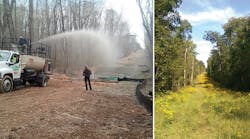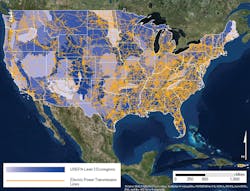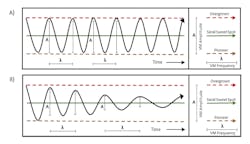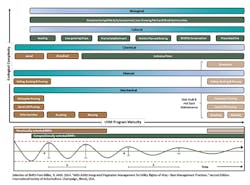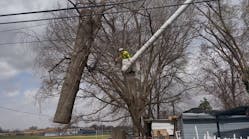Often cited as the guiding doctrine of utility vegetation management programs, integrated vegetation management prescribes a methodology that values diverse, compatible plant communities to achieve long-term management objectives. However, if being honest, how widespread is this activity on the North American grid? Many utilities advertise integrated vegetation management (IVM) research on their websites and in their corporate social responsibility reports, but what percentage of the national grid do these case studies represent?
Utility vegetation managers have grown up with Bramble, Yahner & Byrnes, and Miller et al., but how representative are these studies and standards of the larger energy utility rights-of-way (ROW) network? This question is surprisingly difficult to answer, in part because today the term IVM is often misunderstood and misused to describe standardized cyclic clearing activities, like brushing, mowing and broadcasting nonselective herbicides. Application of IVM best management practices (BMPs) does not necessarily result in IVM. While BMPs are described by the American National Standards Institute (ANSI) A300, Section 7 IVM standards, when they are applied repetitively without the objective of establishing diverse, compatible plant communities, they may fall short of truly integrated programming.
Adding to the confusion, UVM has undergone many changes over the past 60 years since herbicides became mainstream. There is no better time than today to perform a follow-up assessment regarding the state of IVM on the North American grid.
Utilities are doing an excellent job delivering safe and reliable energy to North American consumers. Access to energy nearly every second of every day is unimaginable in many parts of the world and no small feat. Electric and gas T&D ROW traverse nearly every eco-region across the lower 48 states and are estimated to occupy a total land area of 21 million acres, but how many of these acres are maintained by genuine IVM? And, how many more acres could we integrate over the next 10 years? 20 years?
Let’s Be Clear On IVM
To discuss IVM, it is important to start with the definition. Do not skip reading this section; it is important. Misunderstanding the guiding principles of IVM can lead to misuse of the term and distorted results. Yogi Berra famously said, "If you don't know where you're going, you'll end up someplace else."
IVM is "a system of managing plant communities in which managers set objectives, identify compatible and incompatible vegetation, consider action thresholds, and evaluate, select, and implement the most appropriate control method or methods to achieve their established objectives." ANSI A300 goes on to state IVM is not "a set of rigid prescriptions based on set time periods, repeated unselective mowing, or broadcast spraying across entire right-of-way widths without the objective of establishing diverse, compatible plant communities."
Considering this definition, there has been a shift in how some utility vegetation managers and vegetation contractors use the term IVM. Within some—not too many, I hope—work environments, the term IVM more closely resembles the latter description rather than the former. So, how has this happened? How has IVM come to mean something it is not? And why are some electric utilities presenting IVM as case studies rather than an industry BMP?
Deviation of Definition
NASA Astronaut Col. Mike Mullane offers one explanation for the deviation between IVM definition and practice. He describes a disconnect between an expressed standard and actual delivery as normalization of deviance. Normalization of deviance is a natural human tendency, particularly in pressured circumstances, to want to take shortcuts. To accept a lower standard of performance.
Mullane contextualizes normalization of deviance within emergency response and flight situations, but vegetation managers experience similar pressure under regulation. Normalization of deviance occurs when shortcutting does not return negative consequences. Deviated delivery normalizes and standard operating procedures change incrementally over time.
For utility vegetation managers, the Aug. 14, 2003, blackout—purportedly initiated by a vegetation incident—was the watershed moment that began to change how the utility industry applied IVM. Five years after the blackout, regulations were introduced and structural controls dominated the conversation for at least a decade. Utility vegetation managers reacted swiftly to reclaim overgrown ROW that threatened their utilities’ continued operation. Today, more than a decade after regulations were introduced, utility vegetation managers should be aware of this timeline and be careful to recognize normalization of deviance in the definition and intent of IVM. Should utility vegetation managers accept structural controls as the dominant mode of implementing IVM, then the core long-term objectives of IVM (establishing and maintaining compatible plant communities) would be threatened.
The Deviation Dichotomy
Application of IVM BMPs does not necessarily result in IVM. Reliance on standardized clearing BMPs, like brushing, mowing and broadcasting nonselective herbicides, may be better described as structural vegetation maintenance (SVM). Over time, repetitive use of nonselective BMPs may produce very different plant communities than application of selective BMPs. This is because nonselective BMPs cannot guarantee desirable compositional outcomes. On the other hand, tailoring selective BMPs to site-specific plant communities can encourage compatible compositions by selecting against only incompatible species, leaving compatible species to thrive.
It may help to think about vegetation response to treatment as a frequency-intensity function (see diagram above). The vegetation community response frequency-intensity function (solid black line) is bounded by pioneer plant communities (hashed brown line, representing near bare ground) and overgrown plant communities (hashed red line, representing vegetation approaching clearance thresholds). The solid green line represents a seral sweet spot, an optimal diverse, compatible plant community ideal for long-term maintenance of biological control. Integrated pest management defines biological control as the reduction of pest populations (in this case, woody and weedy species) by natural enemies (occupation of a site by compatible species). Biological control is the objective of IVM.
The frequency-intensity function outlines two management regimes:
- SVM is reactive, responding to vegetation with purely structural methods
- IVM is proactive, tailoring BMPs to select against incompatible species, thus promoting biological control by the remaining compatible vegetation.
SVM (the 'A' function in the diagram) describes a repetitive system in which managers prescribe nonselective controls that suppress vegetation until the next cycle is warranted. This system, as ANSI A300 states, employs "a set of rigid prescriptions based upon set time periods, repeated unselective mowing, or broadcast spraying across entire right-of-way widths without the objective of establishing diverse, compatible plant communities." Managing purely for structure is attractive for many reasons, but long-term objectives, like biological control, cost savings, reduction in herbicide use and wildlife habitat conservation, may remain at arm’s length under this regime. Nevertheless, some utilities prefer it because it is relatively simple, has low short-term costs, and requires limited plant identification skills and knowledge of IVM BMPs.
Conversely, IVM (the 'B' function in the previous diagram) describes an adaptive regime in which managers prescribe selective BMPs that inhibit the growth of incompatible species and conserve growing space for compatible plant communities. Within this system, as ANSI A300 states, "managers set objectives, identify compatible and incompatible vegetation, consider action thresholds, and evaluate, select, and implement the most appropriate control method or methods to achieve their established objectives." Managing for composition through IVM harnesses plant community ecology and provides long-term benefits to managers, the environment and society. By shaping plant community composition, managers can maintain structural control while providing resilient early-successional ecosystems resistant to encroachment by undesirable woody and weedy species.
This dichotomy between two methods, SVM and IVM, can be illustrated by grouping BMPs into two categories as shown above. Structurally-oriented BMPs (shown in brown) are used to suppress vegetation indiscriminately while compositionally-oriented BMPs (shown in green) are used to select against incompatible species, conserving compatible on-site vegetation. According to ANSI A300 Version 2 (V2), IVM has five methods (shown in blue)—biological, cultural, chemical, manual and mechanical—and each method contains a set of BMPs. IVM BMPs can be organized through time to facilitate long-term biological control. Ecological complexity is depicted on the Y-axis and increases from bottom to top. UVM program maturity is depicted on the X-axis and increases as IVM programming shifts from reliance on structurally-oriented BMPs to compositionally-oriented BMPs. Structural controls are reintroduced only as necessary for sidewall trimming and hot-spot maintenance.
IVM BMPs are intended to be applied in sequence, transitioning from structurally-oriented BMPs to compositionally-oriented BMPs. In a sense, the biological control method provides an umbrella under which the other four methods operate. ANSI A300 V2 describes biological control as "management of vegetation by establishing and conserving compatible, stable plant communities, using plant competition, animals, insects or pathogens." In other words, within UVM, this is plant community ecology. The biological method is a goal that seeks to reduce the frequency and intensity of BMP applications through establishment and maintenance of compatible communities. After the blackout, utility vegetation managers spent years reestablishing structural control on their networks. Today, with most lines under control, there is no better time to return to compositionally-oriented BMPs and regain added value.
Achieving The Greatest Benefits
Evaluating a utility network for IVM cost savings and ecological benefit varies by utility, but a few assumptions can be made in general. Often, these two management objectives are complementary. Under competitive growth conditions—full sun, suitable topography and soils—SVM is more likely to produce a high-frequency, high-intensity cycle. Cyclic exposure of bare ground will invite the types of weedy pioneer and woody species that are incompatible in ROW environments. Conversely, under competitive growth conditions, establishing and maintaining compatible plant cover discourages incompatible species from encroaching on the ROW.
Maintenance of compatible plant communities not only provides cost savings over time, but managing vegetation as an asset also can provide additional benefits like wildlife habitat conservation. Intentionally managed vegetation provides opportunities for utilities to participate in voluntary conservation initiatives that contribute to social and legal licenses to operate. For example, should the monarch butterfly be listed as a threatened or an endangered species under the U.S. Endangered Species Act in 2019, signatory utilities to the Nationwide Candidate Conservation Agreement for Monarch Butterfly on Energy and Transportation Lands will provide net benefit to the species and continue to operate without development of costly habitat conservation plans or incidental take permits. North American populations of the mighty monarch once numbered in the billions, but that is no longer the case. Conserving the monarch butterfly is a recent example that highlights the magnitude of recent biodiversity loss. It is by no means an outlier.
Biodiversity loss threatens sustainable business and human health, affecting every human being on the planet. Rather than crumble under the weight of apocalyptic tales, utility vegetation managers have an incredible opportunity in front of them. Energy utilities maintain linear ROW spanning 21 million acres across the continental U.S. Maintenance of early successional forb-rich habitats for energy T&D, if managed intentionally for conservation benefit through IVM, can positively affect numerous endangered, threatened and rare species of insect pollinators, birds and other wildlife. Utility vegetation managers can shape the lands they maintain into unremarkable landscapes through regular application of structurally-oriented BMPs or into vibrant wildlife habitat through intentional vegetation management, also IVM.
Final Thoughts
Energy utilities will face many changes over the coming decades. In response to changing social, regulatory and environmental climates, utility vegetation management, a system founded on risk management, would be wise to return to IVM, a system rooted in asset management, to plan for and cope with a rapidly changing world. While energy utilities transition to cleaner and more cost-effective technologies over the coming decades, IVM will contribute to resilient business practices and large-scale conservation efforts.
For Columbia Gas, ArborMetrics Solutions Inc., Grow With Trees and many others, there is no better way forward than to manage for the greater benefit, promoting biodiversity on the landscape while discouraging incompatible vegetation at reduced costs. These organizations reaffirm their commitment to biodiversity management because they see the values, intangible and otherwise.
